Hardware crypto wallets are a type of cold wallets that provide the safest possible means of storing your private keys and signing transactions. They only connect to the internet while transacting, minimizing the chances of a cyberattack.
On the other hand, relying solely on hot wallets that remain connected to the internet makes you sitting ducks for cybercriminals.
You can easily couple these “cold” wallets with their companion apps for a clear signing experience. Alternatively, pairing them with popular “hot” wallets is also possible for greater safety without compromising on the familiar interface.
The market is flooded with hardware wallet manufacturers. I have zeroed in on the most popular hardware crypto wallets with security certifications.
- 1. Ledger
- 2. Trezor
- 3. Tangem Wallet
- 4. SecuX
- 5. OneKey
- 6. ELLIPAL Titan
- 7. D’CENT
- 8. Keystone 3 Pro
- 9. CoolWallet Pro
- Show less
Please note: It’s recommended to keep an offline backup of your private keys. In the absence of which, a hardware wallet becomes a single point of failure, which could result in lost funds if it ever gets stolen, misplaced, or simply malfunctions.
I will now review the hardware crypto wallets, their features and variants in detail.
1. Ledger
Ledger boasts an excellent range of hardware crypto wallets for all budgets. You can either go with a compact USB drive-sized Nano S Plus or a curved e-ink touch display-enabled Ledger Stax. You also have Nano X and Flex, for anyone looking for a middle ground.
Ledger Nano S Plus
This is an entry-level device you can use by connecting it with 64-bit desktop platforms (Windows, macOS, and Linux) and Android-powered smartphones via a USB Type-C cable.
It supports over 15,000 cryptocurrencies, including BTC, ETH, USDT, XRP, SOL, USDC, BNB, and more. Besides, it’s compatible with NFTs and 50+ 3rd party crypto wallets.
While the 1.09-inch monochrome display can be limited in scope, users can simply switch to the Ledger Live application for a full-blown experience.

Nano S Plus is CC EAL 6+ certified, promising top-notch security for a high-stakes crypto portfolio. Please note, this is the highest level of security Ledger currently offers to its consumers. In addition, Ledger S Plus (and Ledger X) are ANSSI CSPN certified, which is not the case with more premium, touch-enabled Ledger offerings.
So why buy more expensive Ledger devices when you can get this for just $79? This is because Nano S Plus doesn’t feature Bluetooth and iOS device connectivity. So consider it’s upgrade, Ledger Nano X ($149), if both of these are important to you. Furthermore, Ledger Flex is better for anyone who is looking for a more smartphone-esque way to manage their crypto transactions.
Ledger Flex
A 2.84-inch e-ink touchscreen, Bluetooth & NFC connectivity, and iOS compatibility make Ledger Flex a substantial upgrade over Ledger Nano S Plus. The grayscale display provides comfort and clarity when reviewing and signing transactions.
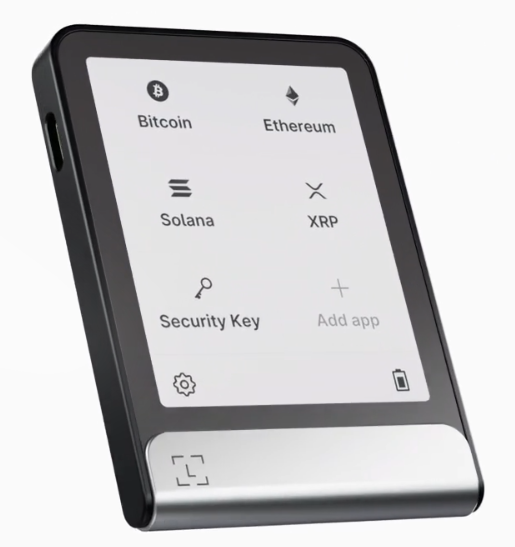
Other than this, you get the same robust security with CC EAL 6+ certification, support for 3rd-party wallets, and an extensive crypto library. You will also have the pleasure of visualizing Ethereum and Polygon NFTs right there on the wallet screen.
The built-in 200 mAh battery can stand by for up to 10 hours or 150 transactions, per Ledger.
You can get Flex for $249. Though it’s enough for most crypto enthusiasts, you can go further with Ledger Stax ($399). This comes with an even bigger 3.7-inch touchscreen and wireless charging.
2. Trezor
Trezor is a hardware wallet pioneer that started this back in July 2014 with the launch of Model One— its most affordable offering to date. As of now, you have three different variants to choose from, supporting thousands of cryptocurrencies. All of those can USB connect with Windows, macOS, Linux, iOS (view-only), and Android-powered devices via the Trezor Suite app.
Trezor Safe 5
Safe 5 is the top-of-the-line Trezor wallet, which comes with a color 1.54-inch touch-capable display protected by Gorilla Glass 3 for scratch resistance. You also get haptic feedback as an added bonus to improve the overall user experience.
This device is EAL 6+ certified and has an open-source firmware. Moreover, Safe 5 allows on-device entry, further negating the chances of man-in-the-middle and phishing cyberattacks.
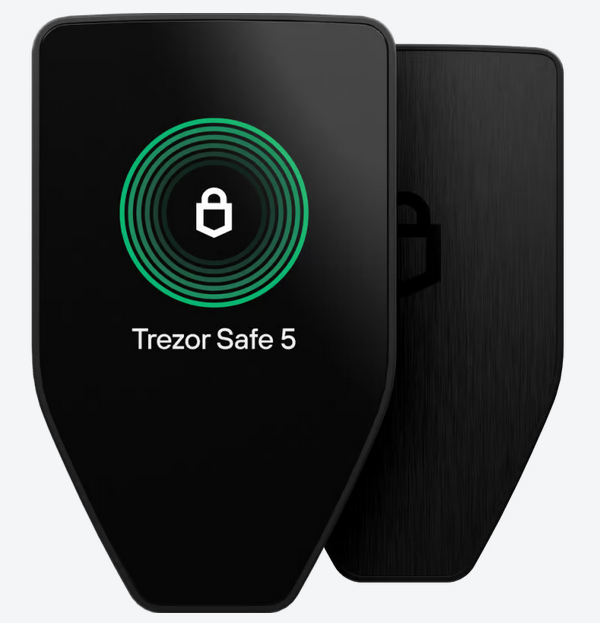
Users also benefit from Safe 5’s multi-share backup (Shamir Backup), in which you can split backup into up to 16 shares and set a minimum threshold needed for account access. Multi-share offers better chances of recovery in comparison to a single share, as long as the user has the threshold shares.
Trezor Safe 5 also has a microSD card slot for PIN encryption. This means you can opt to “bind” the wallet to an SD card, without which the device remains locked.
There are two similarly priced ($169) Safe 5 variants, one supporting multiple crypto coins and the other just made for Bitcoin. But if you can do without the touchscreen and haptic feedback, Trezor Safe 3 is also a good bet for almost half the price of Safe 5.
3. Tangem Wallet
Swiss-engineered Tangem Wallet is a crypto minimalist’s dream come true. Size of a typical credit card, this hardware crypto wallet boasts of IP69K rating, providing maximum possible water and dust protection. Owing to these high standards, Tangem Wallet comes with a 25+ year guarantee.
But there is more to Tangem Wallet than physical durability. For instance, you have the same EAL 6+ certification that the best of Ledgers and Trezors ship with.
This hardware wallet lacks a battery, screen, or buttons, and only works via an NFC-enabled smartphone. Another differentiator is that Tangem Wallet can work without needing a seed phrase at all. Instead, it can simply operate with an on-device, randomly-generated, encrypted private key. However, there are provisions for generating a seed phrase with the Tangem app (Android and iOS) or a 3rd-party crypto wallet and import, if that’s what keeps you at peace.

Tangem’s code is open source and has undergone two independent audits in 2018 and 2023. It lets you protect app access with biometric locks and codes.
Like most of the hardware wallets, Tangem Wallet is a completely autonomous device. There are no connections to Tandem servers. It only connects to the companion app when in operation and stays offline otherwise.
You can buy a two-card ($49.41) or a three-card ($62.91) set, based on how many recovery options you want to keep. A single card with an access code is enough to let you in. Alternatively, you’ll need at least two cards without the code. So technically, more cards provide better chances of recovery, and therefore, Tangem recommends a three-card set. However, consider Tandem Ring if you somehow want all this goodness in another form factor. You can also buy a package of two cards and a ring for $144.
4. SecuX
SecuX has hardware wallets in multiple interesting form factors. You have circular, rectangular, and card-shaped wallets.
SecuX V20
SecuX V20 competes head-to-head with Ledger Flex and Trezor Safe 5. It supports Bluetooth and has a beautiful circular design with aluminum sides, giving a premium feel.
This hardware wallet has a 2.8-inch color touch screen, where you can comfortably verify transactions and browse through your crypto portfolio. It supports 10,000 crypto coins, NFTs, and tokens across 300+ blockchains.

You can connect V20 via Bluetooth, NFC, and USB Type-C port to desktop (Windows, macOS, and Linux) and mobile platforms. SecuX has a browser accessible web app and native apps for iOS and Android.
On the security front, V20 is EAL 5+ certified, ensuring high security standards. However, if I were to nitpick, it still falls short of EAL 6+ certified top-tier Ledger and Trezor devices.
SecuX V20 retails for $139. But you can also opt for SecuX W20 ($99), which comes with a more formal, rectangular design. Both devices are pretty similar, barring the fact that SecuX W20 has a USB Micro B 2.0 port compared to the USB Type-C of V20. Another, a more economical option is SecuX W10 ($59), which you’ve to connect to a computer to operate since it lacks an in-built battery.
Shield BIO
A small, rechargeable 14mAh battery wired inside a credit card design along with a native fingerprint sensor, power on/off buttons, and a 1.1-inch e-link display. Interested?
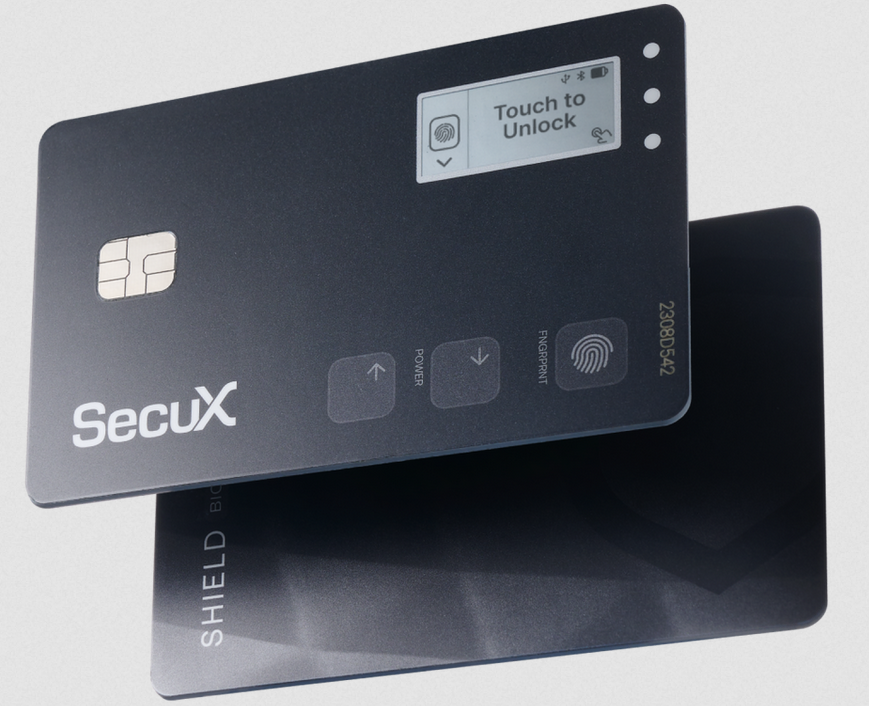
This is Shield BIO, a compact yet advanced hardware wallet from SecuX. It gets the same 10k coins support and EAL 5+ certification as SecuX V20 and W20.
Shield BIO is Bluetooth-enabled and comes with a USB charging dock. The battery is stated to maintain a full charge for several months when idle and can support up to 60 minutes of non-stop action.
The only obvious limitation is that you’ll use it mostly via the SecuX application since the e-ink screen has hardly enough real estate.
As of now, this card-sized hardware wallet is up for grabs for $149.
5. OneKey
OneKey has a range of hardware wallets for crypto investors. From big displays to entirely battery-free models, the lineup is really worth considering.
OneKey Pro
OneKey Pro is an EAL 6+ certified, touch screen-enabled, hardware wallet that lets you benefit from air-gapped (QR code-based) transaction signing for maximum security. You can use OneKey Pro with Windows, macOS, Linux, Android, and iOS devices via the companion application.
This beautiful-looking hardware wallet has a side-mounted fingerprint sensor, haptic feedback, wireless and USB-C charging, Bluetooth, and NFC support.

OneKey Pro is compatible with over 5000 coins and tokens. You can also store and transact NFTs via “Pro.”
The 3.5-inch color display works great for on-device transaction signing. You can simply scan the QR code with the built-in camera and verify the details upfront before using a computer to sign off on the transactions.
OneKey Pro is a flagship device priced at $278. Though OneKey has multiple cheaper alternatives, I will highlight Class 1S, as it’s perfect for anyone looking for similar blockchain support and security.
OneKey Classic 1S
Class 1S is a “thin as a card” crypto wallet that offers similar access to 5000+ crypto coins and NFT support as OneKey Pro, but only at $99.
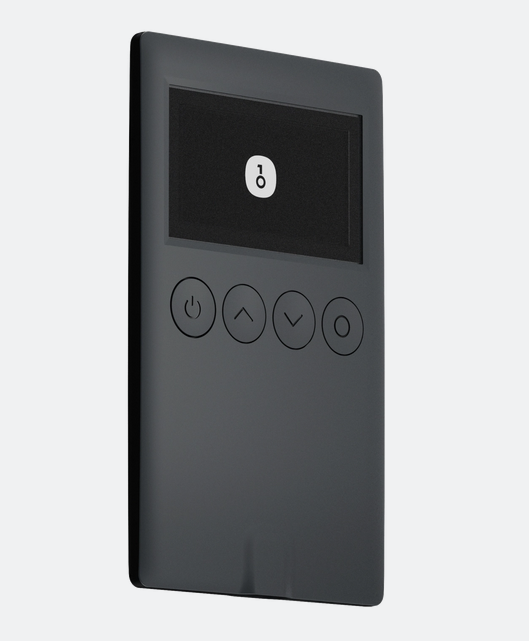
This is also EAL 6+ certified, has on-device entry, and a USB-C port and Bluetooth connectivity. Likewise, Classic 1S is compatible with Windows, macOS, Linux, iOS, and Android.
Besides its apps, one can use OneKey Classic 1S with any Chrome browser via its browser extension.
6. ELLIPAL Titan
With a 4-inch display, ELLIPAL Titan resembles a compact smartphone more than a crypto wallet. This comparatively large screen enables you to verify complete transaction details before signing.
You can transact easily and securely without connecting this wallet to any device— all thanks to its QR-based, air-gapped transaction signing. It also features EAL 5+ certification, assuring its users of decently high security standards for a consumer device. And this crypto wallet automatically self-destructs upon detecting tampering. Overall, ELLIPAL has done an impressive job in keeping the wallet safe against online and offline attacks.

ELLIPAL Titan can handle up to 10 accounts at a time. Though the screen is big enough for day-to-day crypto management, you can have it better via its web and native apps (for iOS and Android).
Titan is compatible with over 10,000 coins and NFTs (Ethereum and Polygon) across 40+ blockchains.
ELLIPAL Titan is available for $169. You can also get the package of a seed phrase storage plate and the wallet for $199.
A cheaper and slim offering is ELLIPAL X—a credit card-shaped cold wallet for $69. This comes with the same blockchain compatibility as the “Titan” and with even better EAL 6+ certification.
7. D’CENT
D’CENT Biometric wallet puts a fingerprint sensor as the first line of defense. Although you can also set a PIN, biometric authentication lets you quickly and easily approve transactions with just a “touch”.
As of now, you get to play with over 3600 crypto tokens and NFTs at 70+ blockchain networks. It supports creating up to 80 wallets.
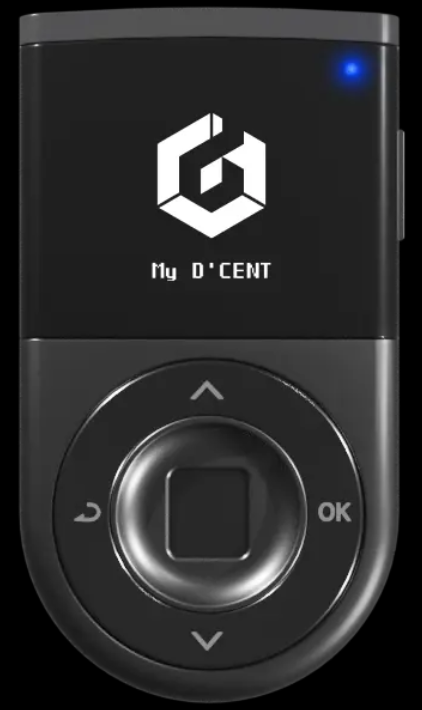
You have its OLED screen to see the complete wallet address without connecting to a bigger device. However, you can indeed connect it with desktop and mobile platforms (apps for iOS and Android) with USB (Type C and B) and Bluetooth.
D’CENT biometric wallet is EAL 5+ certified. Besides, private keys stay encrypted on the device, negating phishing attacks.
D’CENT biometric wallet retails for $139. Like its peers, D’CENT also offers a card wallet with similar coin and NFT support at just $38.
8. Keystone 3 Pro
Keystone 3 Pro is an air-gapped hardware crypto wallet with a 4-inch color touchscreen to effortlessly and securely manage web3 transactions. You get detailed transaction data, including full wallet address and smart contracts, for verification before signing.
This wallet supports multiple seed phrases, allowing you to separately store funds in primary (major deposits) and secondary (routine, low-value transactions) wallet setups. And you can rest assured the assets remain secure even if the wallet gets stolen, since it self-destructs upon detecting tampering or sabotage.

Keystone 3 Pro is equipped with a fingerprint scanner for biometric authentication. It also features Shamir backup for avoiding centralized recovery mechanisms. Interestingly, you can add an extra 25th word to the standard 24-word recovery phrase, further enhancing the overall security posture.
Keystone 3 Pro supports over 5000 crypto coins and tokens. Plus, you can use 35+ software wallets in tandem with your Keystone, providing the best of both worlds.
Currently, it costs $149. You can also get a customized variant for $249.
9. CoolWallet Pro
CoolWallet Pro is a card-shaped hardware wallet with a small rechargeable battery, a calculator-style display, and a conveniently placed button. It connects to your iOS and Android-based smartphones via Bluetooth for crypto operations.
CoolWallet Pro supports 35+ blockchains. Moreover, you can invest in multiple other projects by adding any EVM-compatible network, ERC-20, BEP-20, or TRC-20 tokens, and ERC-721/ ERC-1155 NFT tokens.
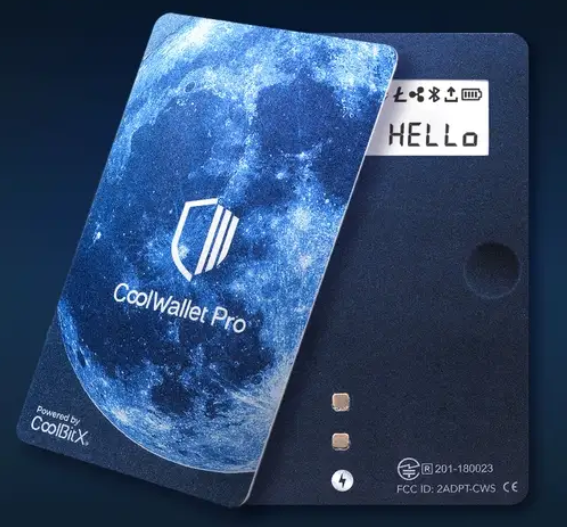
This hardware wallet is CC EAL 6+ certified, ensuring high standards for private key storage, transaction security, and tampering resistance.
CoolWallet Pro is priced at $149.02. They also have a CoolWallet S, a slightly stripped-down version for $99.
What’s a Crypto Wallet?
Unlike a regular wallet that keeps fiat currencies, a crypto wallet only keeps your private keys. Your crypto, anyway, lives on the blockchain.
In addition, they allow you to transact in cryptocurrencies. And you can also use DeFi (Decentralized Finance) and Decentralized Applications (dApps) with them.
Put simply, a crypto wallet gives you access to everything blockchain.
Types of Wallets: Hot and Cold
In a nutshell, hot wallets are software applications. Most hot wallets are free to use and sit on the installed device.
Sounds good? Not so fast!
One major drawback is their constant internet connectivity. They are susceptible to phishing or spyware attacks. So, a hacker can steal your private keys if you aren’t vigilant enough.
Therefore, if you can protect yourself from cyber threats or have recently started with crypto, download a hot wallet.
I recommend trying Metamask (for Ethereum blockchain) before looking elsewhere.
For others, and especially serious investors, hardware wallets are the way to go.
Hardware wallets are coupled with an application operated from a desktop or smartphone. They connect to these devices wirelessly or via a cable.
And they are perceived as safe because they connect to the internet (become hot) only while transacting. Besides, some never connect to the internet or any other device and instead sign transactions via a QR code.
Benefits of A Hardware Crypto Wallet
Except for the initial price tag, hardware wallets clearly edge out hot wallets in crucial aspects.
- Best Private Keys Vault: They are the safest place to keep your private keys. You do not trust an exchange or software.
- Extra Layer of Security: You can set a PIN to ensure nobody has access to your wallet. In addition, integrated applications allow setting a password for extra security.
- Transaction Verification: You physically verify each transaction. That’s much like signing a check.
- Practically Unhackable: A regular computer virus is irrelevant to a cold wallet. Your computer can get corrupt, but your hardware wallet probably won’t.
Conclusion
Hardware wallets are a no-brainer for serious crypto investors. They are necessary one-time investments if you’re planning to stay in there for long.
Notably, it’s essential to check the supported coins at the time of purchase because your wallet will be useless if it doesn’t support the coin of your choice.
Finally, make sure you purchase only from company stores or authorized retailers to avoid getting a compromised device (~supply chain attacks).
-
 EditorUsha, the editor-in-chief of Geekflare, is a tech-savvy and experienced marketer with a Master’s degree in Computer Applications. She has over a decade of experience in the tech industry, starting as a software engineer and then moving into digital marketing and team management.
EditorUsha, the editor-in-chief of Geekflare, is a tech-savvy and experienced marketer with a Master’s degree in Computer Applications. She has over a decade of experience in the tech industry, starting as a software engineer and then moving into digital marketing and team management.


